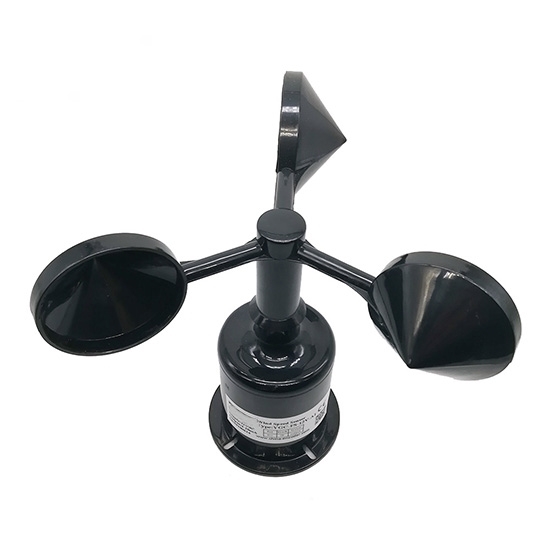The working principle of cup anemometer
The wind cup wind speed sensor is a very common anemometer, which was first invented by British Robinson. The induction part is composed of three or four conical or hemispherical empty cups. The hollow cup shell is fixed on a three-pointed star-shaped bracket that is 120° to each other or a cross-shaped bracket that is 90° to each other. The concave surface of the cup is arranged in one direction, and the entire cross arm is fixed on a vertical rotation axis.
When the wind blows from the left, the cup 1 is parallel to the wind direction, and the component force of the pressure of the wind on the cup 1 in the direction closest to the cup axis is approximately zero. Cups 2 and 3 intersect with the same wind direction at an angle of 60 degrees. For cup 2, its concave surface faces the wind and bears the largest wind pressure. The convex surface of the cup 3 faces the wind, and the wind around the wind makes the wind pressure less than that of the cup 2. Due to the pressure difference between the cup 2 and the cup 3 in the direction perpendicular to the wind cup axis, the wind cup begins to flow smoothly. Clockwise rotation, the greater the wind speed, the greater the initial pressure difference, the greater the resulting acceleration, and the faster the wind cup rotates.

After the cup starts to rotate, because the cup 2 rotates in the direction of the wind, the pressure of the wind is relatively reduced, while the cup 3 rotates against the wind at the same speed, the wind pressure is relatively increased, and the wind pressure difference continues to decrease. , After a period of time (when the wind speed is constant), when the partial pressure difference acting on the three wind cups is zero, the cups will rotate at a uniform speed. In this way, the wind speed can be determined according to the rotation speed of the cup (the number of revolutions per second).
When the cup rotates, it drives the coaxial multi-tooth cutting disc or the magnetic rod to rotate, and the pulse signal proportional to the rotation speed of the cup is obtained through the circuit. The pulse signal is counted by the counter, and the actual wind speed value can be obtained after conversion. At present, the new rotor anemometers all use three cups, and the performance of the conical cup is better than that of the hemispherical cup. When the wind speed increases, the rotor can rapidly increase the rotation speed to adapt to the airflow speed. When the wind speed decreases, due to the influence of inertia, the rotation speed However, it cannot drop immediately. The wind speed indicated by the rotary anemometer in the gust is generally too high, which becomes an excessive effect (the average error generated is about 10%)
The working principle of ultrasonic anemometer
The working principle of the ultrasonic anemometer is to use the ultrasonic time difference method to measure the wind speed. Because of the speed of sound in the air, it will be superimposed with the speed of the airflow in the wind direction. If the ultrasonic wave travels in the same direction as the wind, its speed will increase. Conversely, if the propagation direction of the ultrasonic wave is opposite to the wind direction, its speed will be slower. Therefore, under fixed detection conditions, the speed of ultrasonic propagation in the air can correspond to the wind speed function. The precise wind speed and direction can be obtained by calculation. Since a sound wave travels through the air, its speed is greatly affected by temperature. The wind sensor detects two opposite directions on the two channels, so the temperature has a negligible effect on the speed of the sound waves.
Ultrasonic wind speed sensor has the characteristics of light weight, no moving parts, strong and durable, and does not require the maintenance and field calibration of ordinary anemometers, and can output wind speed and wind direction at the same time. Customers can choose the wind speed unit, output frequency and output format according to their needs. You can also choose a heating device (recommended in icy environments) or analog output as needed. It can be used with computers, data collectors or other acquisition equipment with RS 485 or analog output. If necessary, multiple units can also be used to form a network. Ultrasonic anemometer is a relatively advanced instrument for measuring wind speed and direction. Because it overcomes the inherent defects of mechanical anemometers well, it can work normally all-weather and long-term, and is used more and more widely. It will be a strong replacement for mechanical anemometers.
